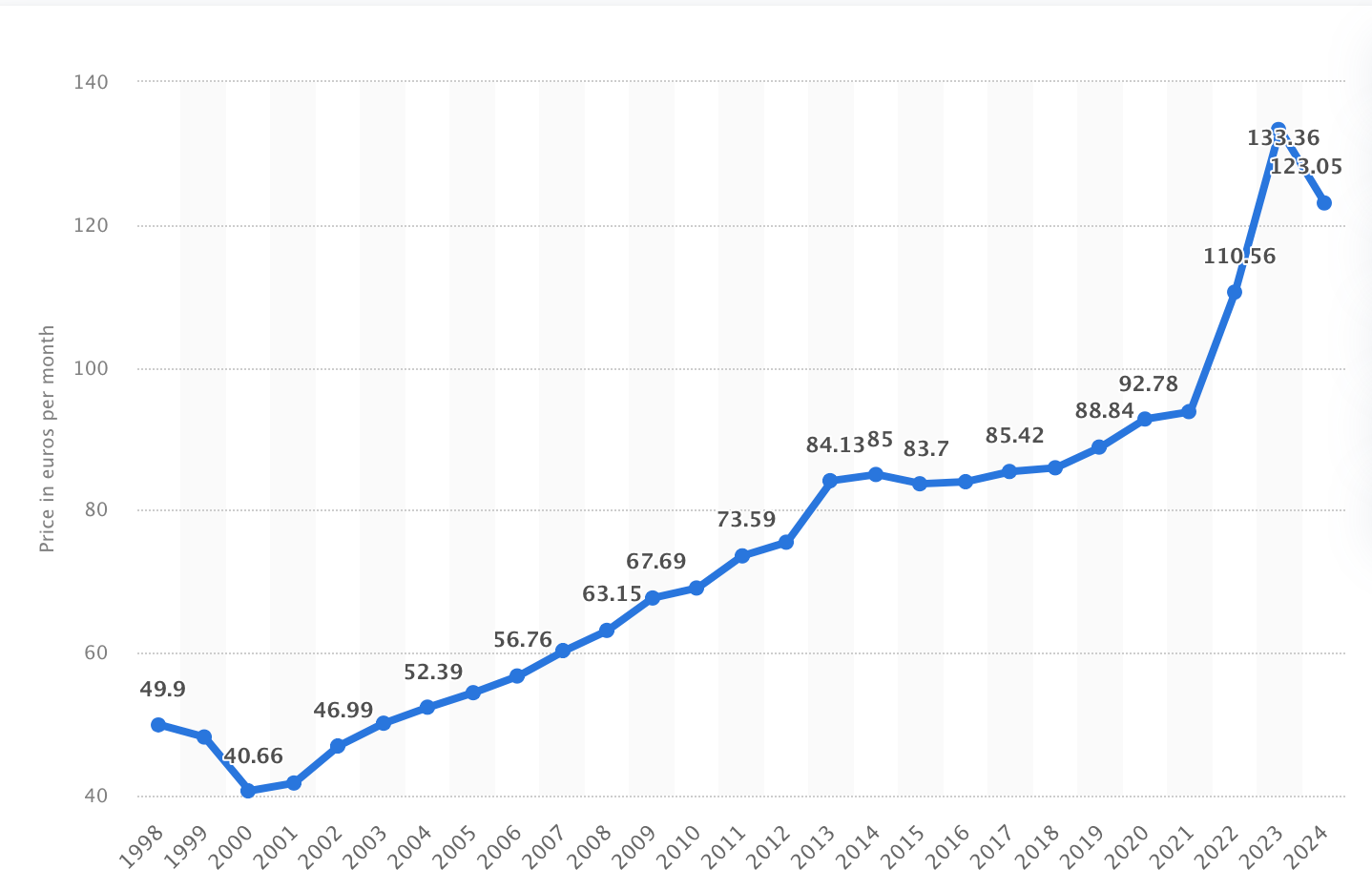Free Fallin’
Anyone who has been following the “Energiewende” (energy transition) in earnest is surely aware of the slow-motion Autobahn crash that is the current German economy. Once the engineering and manufacturing superpower of Europe, Germany has been brought to its knees after two decades of ideologically-driven mismanagement of energy policy.
The most recent chapter in this tale of woe was published by investigative journalists at Cicero Magazine in April, revealing documents that proved Vice-Chancellor Robert Habeck intentionally suppressed information and lied to the public about the safety and critical necessity of continuing operation of the country’s remaining nuclear plants. The false reports ultimately led to the shuttering of Germany’s last reactor in 2023. In the aftermath of Russia’s invasion of Ukraine in 2022, the German Ministry of the Environment conducted an internal study on the safety and economic feasibility of extending the life of its last three nuclear energy facilities. The government’s conclusion unequivocally stated that the plants were safe and affordable to operate. However, Habeck and his Green Party conspirators quashed the publication of the study, instead misleading the public with fake documentation showing that the “Atomausteig” (exit from nuclear) must continue because the plants were fundamentally unsafe and too expensive to operate, and that their use would impede Germany’s “Energiewende” climate goals.
These statements couldn’t be further from the truth. The fact is, with the severe reduction of Russian natural gas imports, coupled with the closure of Germany’s last zero emissions nuclear plants, the country’s only remaining option would be to re-open lignite coal plants, one of (if not the most) polluting sources of electricity in the industrialized world. And this is exactly what has happened. Germany has brought back online about 20 decommissioned and soon-to-be decommissioned coal plants. An estimated additional 15.8 million tons of CO2 were released by these coal operations in 2022. Although seven of the plants were closed down again in March 2024, German electricity reliability now hangs by a thread, and all it will take is a harsh winter to force more coal back into the grid mix. How’s that for a brownish shade of green.
Dire Straits
Meanwhile, the effect of this topsy-turvy energy policy on the German economy has been devastating. Retail household electricity prices in Germany were the highest in all of the EU in 2023, at €0.4020 per KWh (41% higher than the EU average). This steep rate hike is directly correlated to Germany’s closure of its nuclear plants, compounded by the natural gas crunch resulting from Russia’s war in Ukraine. As observed in the graph below, the average electricity bill for a 3-person household increased by about 44% between 2022 and the end of 2023.

While average Germans struggle to pay their household utility bills, serious damage is also accruing to the country’s GDP, ultimately instigating a negative feedback loop that further lowers the quality of life for everyone. U.S.-provided liquefied natural gas (LNG) has offered a lifeline to the German chemical and manufacturing industries that depend on natural gas to synthesize ammonia and provide process heat. However, the overall high cost of energy has cut deep into the profits of Germany’s biggest firms, including chemical giant BASF, and automotive companies such as Volkswagen, both of which have publicly announced an exit of some of their operations to overseas facilities. A study by Deloitte in 2023 found that about two-thirds of German companies had partially exported their manufacturing to China and other countries with cheaper energy and labor costs. The graph below shows the severe hit taken by energy-intensive industrial production in Germany since 2022:

Origin Story
So, how did Germany get into this mess? The story begins in 2000, when the German Bundestag enacted the Renewable Energy Source Act (EEG), introducing feed-in tariffs as a main policy instrument to subsidize wind and solar renewable energy companies, allowing them to compete against established conventional energy providers despite a lack of outward profitability. In 2010, under Angela Merkel’s CDU-CSU leadership, the EEG was enhanced by the Energy Concept, introduced by the Ministry of Economics and Technology with a policy goal aiming for 40% reduction of greenhouse gas by 2020, compared to 1990 baseline measurements, as well as a 60% share of renewables in the electricity grid by 2050. The EEG has since been amended to the (completely deranged and out-of-touch) target of 80% renewables by 2030. Simultaneously, in the wake of the Fukushima disaster, the Bundestag in 2011 committed to a phase-out of all German nuclear energy plants by 2022.
The policy directives outlined above have had two important ramifications leading to the current German energy crisis: 1) over-reliance on unreliable wind and solar installations initially made the economy more dependent on Russian natural gas to supply baseload energy; 2) the closure of German nuclear plants (and with them the country’s main sources of domestic baseload) further placed the economy at the mercy of Russia. It does not take a nuclear physicist to predict what happened next: the inevitable crippling of the highly industrialized German economy when Russia cut its natural gas exports to the EU by 30%.
Hoodwinked
The facts presented above are apparent at the surface. But to truly understand why the Germans (who are generally no dummkopfs) allowed this travesty to occur, it is important to analyze the role that the German Green Party has wielded since the beginning of the environmental movement. The anti-nuclear agenda is core to the Green Party’s identity, and has been perhaps its raison d’etre since the party’s founding in the 1970s. Both when in and out of leadership coalitions in the federal government, the Greens have projected an outsized influence on all things vaguely related to environmental policy for decades. If the Green Party has been successful at one thing, it’s using its reputation as so-called defender of the planet to crown itself as the end-all, be-all of ethical conduct in crafting sustainable energy policy. This deferential mindset towards the Greens has allowed Green-backed policies based on little more than ideology to run rough-shod over competing interests that are solidly based in physics and economics, such as nuclear energy.
More sinister, environmental groups working in tandem with the Green Party have been accused of intentionally colluding with Russia to make the EU dependent on Russian natural gas, through the proliferation of poor-performing wind and solar operations that must be supported by uninterruptible power sources during those not-so-infrequent occasions when the sun doesn’t shine and the wind doesn’t blow (Dunkelflaute). A memo submitted to the European Parliament by Polish member Witold Jan Waszczykowski in 2022 requested the Parliament to take up a question addressing this alleged collusion, including anti-nuclear activities propagated by EU NGOs at the behest of Russian lobbyists.
Go West, Young Green!
If any of this sounds familiar to the American audience, it’s because it should. California seems hellbent on following Germany right off the economic cliff. Earlier this year, California’s retail electricity rates skyrocketed to the highest in the contiguous United States ($0.32/kWh). Only Hawaiians pay more ($0.45/kWh), and that is largely due to the island’s extreme geographic isolation and lack of endogenous energy resources. As I have discussed previously, California’s three investor-owned utilities (IOUs) will spend nearly $50 billion to install 25.5GW of solar and wind renewables and 15GW of storage through 2032, and this plan most likely will serve as a mandate to the Public Utilities Commission to authorize more rate hikes. This spending is to satisfy the policy whims of the legislature, who expect the state to whip up net zero energy usage by 2045, literally out of thin air.
Adding insult to injury, California is also following Germany’s path in mothballing its nuclear capacities. With the decommissioning of San Onofre Nuclear Generating Station (near San Diego) in 2013, only one plant in the state remains operational: Diablo Canyon Power Plant (DCPP) in San Luis Obispo County. DCPP provides some 10% of California’s electricity generation, and yet it has been slated for closure in 2030, in order to meet the state’s wind and solar targets and to appease the astroturfed anti-nuclear “environmental” lobby. It only remains open today due to the hard work of activists for a rational energy policy, such as Californians for Green Nuclear Power (CGNP), who convinced Governor Gavin Newsom to extend its license (thereby avoiding total grid collapse).
What we are clearly witnessing in California (and other foolhardy states) is a carbon copy of Germany’s failed energy policies — only a few years behind. A prudent state government might see Germany’s plight as a red-glowing warning sign and reverse course, post haste.
But we don’t talk about Germany, nein, nein, nein.
Electrically yours,
K.T.





Dieter's Trauma continues! Thank you for the excellent 👍 article
All self inflicted, and so opposite Germanic and Prussian traditional values.
Putin's KGB masterstroke, a true evil genius, ultimately eating the West's lunch.
https://tucoschild.substack.com/p/putins-kgb-masterstroke-fracking
Nice article, I'm German and can confirm most things.
However, I think you shouldn't underestimate the American influence on the Greens. The first Green government in the late 1990s send German troops to Kosovo, following the American intervention there. It is now also the Greens that are the loudest in demanding more and more aid and practically direct intervention of German and NATO forces in Ukraine. That's hardly because they work for the Russians.
Let's not forget that someone blew up Nordstream (definetely neither Russians or Ukrainians did this), which led to a very nice business case for American LNG exporters.
Also, with the US now reshoring, the German industry has become a competition for American companies and with the Inflation Reduction Act, the US tries actively to bring companies from expensive Germany to the US.
Russia was a reliable partner for cheap energy and other raw materials for Germany. Without this, we are truly f*cked.